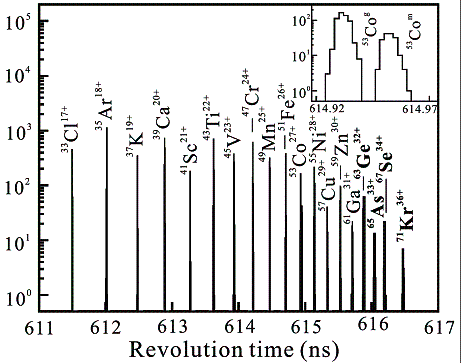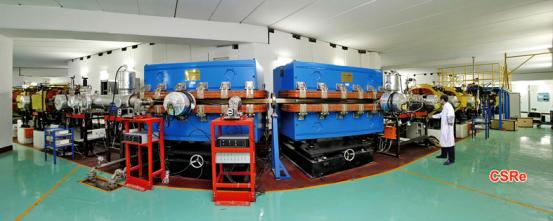Researchers of Institute of Modern Physics (IMP), CAS succeeded in conducting a precisemass measurement of short-lived nuclides at the Cooler Storage Ring of the Heavy Ion Research Facility in Lanzhou (HIRFL-CSR) using isochrnous mass spectrometry. Scientists from six countries participated in this experiment. The masses of 63Ge, 65As, 67Se, and 71Kr nuclides are directly measured with an accuracy of δm/m~10-6 for the first time. The results of this investigation have been published in Physical Review Letters, 106, 112501 (2011).
The proton separation energy of 65As is determined to be Sp=-90±85 keV; this confirms the proton-unbound nature of 65As against proton emission and fixes the proton drip-line position in Arsenic isotopes. Of particular importance, this value and its error allow for establishing the astrophysical conditions under which 64Ge is a waiting point in the rp process of stellar nucleosynthesis. In the framework of the Type I X-ray burst model, the precision of 65As mass determination eliminates almost completely the uncertainties in the calculation of the light curves and it yields a main reaction flow passing through 64Ge by proton capture, indicating that 64Ge is not an rp-process waiting point. While the new mass values for 63Ge, 65As, and 67Se agree very well with the predictions of the Coulomb displacement energy (CDE) calculations, a disagreement between the CDE value and the measured mass for 71Kr has been found. This may hint at a structure change along the N=Z line at N=Z=35 and suggest that the effects of deformation and shape-coexistence need to be considered in future CDE calculations.
Nuclear mass is a fundamental property of nucleus which reflects complex interplay of interactions in the nucleus. Nuclear masses find their applications in nuclear structure, nuclear astrophysics, as well as in testing the standard model and fundamental symmetries. Owing to the broad range of applications, mass spectrometry is a rapidly developing field world-wide in nuclear physics. In the coming years, precisemass measurement of the short-lived nuclides will be a research focus at IMP.

Fig.1. The revolution time spectrum zoomed in on a subset of the A=2Z-1 nuclides. The inset shows the well-resolved ground and isomeric [T1/2=247 ms, E=3174.3(1.0)keV] states of 53Co.(Image by Institute of Modern Physics)

Fig.2 The HIRFL-CSR at IMP(Image by Institute of Modern Physics)

